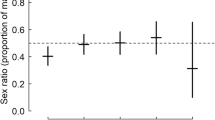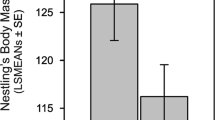Abstract
Non-random sex allocation in relation to parental, ecological and phenological factors has been investigated in several correlational studies of birds, mostly based on few breeding seasons and relatively small sample sizes, which have led to different results. We investigated sex ratio of nestling barn swallows (Hirundo rustica) in relation to adult sex ratio, laying date, clutch size, colony size and meteorological conditions in a sample of 553 broods (>2200 nestlings) during 10 years. At the population level, nestling sex ratio varied among years and deviated from parity in two years. Sex ratio among adults did not predict offspring sex ratio in the current or the following year. At the within-family level, the proportion of sons increased with laying date in large clutches, did not vary among clutches of intermediate size, and tended to decline with laying date in small clutches. Large colonies harbored more sons. The proportion of males increased with temperature during laying whereas the effects of temperature during the pre- or post-laying periods and that of rainfall were non-significant. These patterns of variation of offspring sex ratio did not differ between years. Thus, we identified several potential causal sources of variation in barn swallow offspring sex ratio, including temporal, phenological and ecological factors. The observation of an association of offspring sex with temperature during laying is novel for birds and may be mediated by effects on maternal steroid hormones profile. The ecological and evolutionary implications of present findings are discussed in the light of adaptive sex allocation theory.




Similar content being viewed by others
References
Ambrosini R, Bolzern AM, Canova L, Arieni S, Møller AP, Saino N (2002) The distribution and colony size of barn swallows in relation to agricultural land use. J Appl Ecol 39:524–534
Allsop DJ, Warner DA, Langkilde T, Du W, Shine R (2006) Do operational sex ratios influence sex allocation in viviparous lizards with temperature-dependent sex determination? J Evol Biol 19:1175–1182
Appleby BM, Petty SJ, MacDonald DW (1997) Does variation of sex ratio enhance reproductive success of offspring in tawny owls (Strix aluco)? Proc R Soc Lond B 264:1111–1116
Arnold KE, Griffiths R, Stevens DJ, Orr KJ, Adam A, Houston DC (2003) Subtle manipulation of egg sex ratio in birds. Proc R Soc Lond B 270:S216–S219
Badyaev AV, Hill GE, Beck ML, Dervan AA, Duckworth RA, McGraw KJ, Nolan PM, Whittingham LA (2002) Sex-biased hatching order and adaptive population divergence in a passerine bird. Science 295:316–318
Bensch S, Westerdahl H, Hansson B, Hasselquist D (1999) Do females adjust the sex of their offspring in relation to the breeding sex ratio? J Evol Biol 12:1104–1109
Bradbury RB, Blakey JK (1998) Diet, maternal condition, and offspring sex ratio in the zebra finch, Poephila guttata. Proc R Soc Lond B 265:895–899
Budden AE, Beissinger SR (2004) Against the odds? Nestling sex ratio variation in green-rumped parrotlets. Behav Ecol 15:607–613
Burley NT (1981) Sex ratio manipulation and selection for attractiveness. Science 211:721–722
Chicon M, Dubiec A, Stoczko M (2003) Laying order and offspring sex in blue tits (Parus caeruleus). J Avian Biol 34:355–359
Correa SM, Adkins-Regan E, Johnson PA (2005) High progesterone during avian meiosis biases sex ratios towards females. Biol Lett 1:215–218
Crawley MJ (1993) GLIM for ecologists. Blackwell Scientific, Oxford
Ellegren H, Gustafsson L, Sheldon BC (1996) Sex ratio adjustment in relation to paternal attractiveness in a wild bird population. Proc Natl Acad Science, USA 93:11723–11728
Ferrari RP, Martinelli R, Saino N (2006) Differential effects of egg albumen content on barn swallow nestlings in relation to hatch order. J Evol Biol 19:981–993
Fisher RA (1958) The genetical theory of natural selection, 2nd edn. Dover Publications Inc., New York
Frigerio D, Dittami J, Mostl E, Kotrschal K (2004) Excreted corticosterone metabolites co-vary with ambient temperature and air pressure in male greylag geese (Anser anser). Gen Comp Endocrinol 137:29–36
Galeotti P, Saino N, Sacchi R, Møller AP (1997) Song correlates with social context, testosterone and body condition in male barn swallows. Anim Behav 53:687–700
Göth A, Booth DT (2005) Temperature-dependent sex ratio in a bird. Biol. Lett. 1:31–33
Griffiths R, Double MC, Orr K, Dawson RJG (1998) A DNA test to sex most birds. Mol Ecol 7:1071–1075
Hasselquist D, Kempenaers B (2002) Parental care and adaptive brood sex ratio manipulation in birds. Phil Trans R Soc Lond B 357:363–372
Krebs EA, Green DJ, Double MC, Griffiths R (2002) Laying date and laying sequence influence the sex ratio of crimson rosella broods. Behav Ecol Sociobiol 51:447–454
Komdeur J, Daan S, Tinbergen J, Mateman AC (1997) Extreme adaptive modification in sex ratio of the Seychelles warbler’s eggs. Nature 385:522–525
Komdeur J, Pen I (2002) Adaptive sex allocation in birds: the complexities of linking theory and practice. Phil Trans R Soc Lond B 357:373–380
Johnson AL (1996) The avian ovarian hierarchy: a balance between follicle differentiation and atresia. Poultry Avian Biol Rev 7:99–110
Johnson AL (2000) Reproduction in the female. In: Whitlow CG (ed) Avian Physiology. Academic Press, London, pp 569–596
Le Galliard JF, Fitze PS, Cote J, Massot M, Clobert J (2005) Female common lizards (Lacerta vivipara) do not adjust their sex-biased investment in relation to the adult sex ratio. J Evol Biol 18:1455–1463
Littell RC, Milliken GA, Stroup WW, Wolfinger RS (1996) SAS system for mixed models. SAS Institute Inc., Cary, North Carolina
Møller AP (1994) Sexual selection and the barn swallow. Oxford University Press, Oxford
Nager RG, Monaghan P, Griffiths R, Houston DC, Dawson R (1999) Experimental demonstration that offspring sex ratio varies with maternal condition. Proc Natl Acad Sci USA 96:570–573
Norris DO (1997) Vertebrate Endocrinology. Academic Press, Boston
Pen I, Weissing FJ (2002) Optimal sex allocation: steps towards a mechanistic theory. In: Hardy ICW (ed) Sex ratios: concepts and research methods. Cambridge University Press, Cambridge, pp 26–45
Pike TW, Petrie M (2005) Offspring sex ratio is related to paternal train elaboration and yolk corticosterone in peafowl. Biol Lett 1:204–207
Pike TW, Petrie M (2006) Experimental evidence that corticosterone affects offspring sex ratios in quail. Proc R Soc Lond B 273:1093–1098
Radford AN, Blakey JK (2000) Is variation in brood sex ratios adaptive in the great tit (Parus major)? Behav Ecol 11:294–298
Ranta E, Lummaa V, Kaitala V, Merila J (2000) Spatial dynamics of adaptive sex ratios. Ecol Lett 3:30–34
Remage-Healey L, Romero M (2001) Corticosterone and insulin interact to regulate glucose and trygliceride levels during stress in a bird. Am J Physiol Regul Integr Comp Physiol 281:R994–R1003
Romanoff AJ (1960) The avian embryo. MacMillian, New York
Rosivall B, Torok J, Hasselquist D, Bensch S (2004) Brood sex ratio adjustment in collared flycatchers (Ficedula albicollis): results differ between populations. Behav Ecol Sociobiol 56:346–351
Rozenboim I, Mobarky N, Heiblum R, Chaiseha Y, Chang SW, Biran I, Rosenstrauch A, Sklan D, El Halawani ME (2004) The role of prolactin in reproductive failure associated with heat stress in the domestic turkey. Biol Repr 71:1208–1213
Rutstein AN, Gorman HE, Arnold KE, Gilbert L, Orr KJ, Adam A, Neger R, Graves JA (2005) Sex allocation in response to paternal attractiveness in the zebra finch. Behav Ecol 16:763–769
Saino N, Ambrosini R, Martinelli R, Calza S, Møller AP, Pilastro A (2002a) Offspring sexual dimorphism and sex-allocation in relation to parental age and paternal ornamentation in the barn swallow. Mol Ecol 11:1533–1544
Saino N, Ambrosini R, Martinelli R, Møller AP (2002b) Mate fidelity, senescence in breeding performance, and reproductive trade-offs in the barn swallow. J Anim Ecol 71:309–319
Saino N, Calza S, Møller AP (1997) Immunocompetence of nestling barn swallows (Hirundo rustica) in relation to brood size and parental effort. J Anim Ecol 66:827–836
Saino N, Ellegren H, Møller AP (1999) No evidence for adjustment of sex allocation in relation to paternal ornamentation and paternity in barn swallows. Mol Ecol 8:399–406
Saino N, Romano M, Ambrosini R, Ferrari RP, Møller AP (2004a) Timing of reproduction and egg quality covary with temperature in the insectivorous barn swallow (Hirundo rustica). Funct Ecol 18:50–57
Saino N, Romano M, Ferrari RP, Martinelli R, Møller AP (2003). Maternal antibodies but not carotenoids in barn swallow egges covary with embryo sex. J Evol Biol 16:516–522
Saino N, Szèp T, Romano M, Rubolini D, Møller AP (2004b) Ecological conditions during winter predict arrival date at the breeding quarters in a trans-Saharan migratory bird. Ecol Lett 7:21–25
Sheldon BC, Andersson S, Griffith SC, Ornborg J, Sendecka J (1999) Ultraviolet colour variation influences blue tit sex ratios. Nature 402:874–877
Thuman KA, Widemo F, Griffith SC (2003) Condition-dependent sex allocation in a lek-breeding wader, the ruff (Philomachus pugnax). Mol Ecol 12:213–218
Trivers RL, Willard DE (1973) Natural selection of parental ability to vary the sex ratio of offspring. Science 177:90–92
Veiga JP, Viñuela J, Cordero PJ, Aparicio JM, Polo V (2004) Experimentally increased testosterone affects social rank and primary sex ratio in the spotless starling. Horm Behav 46:47–53
Warner DA, Shine R (2007) Reproducing lizards modify sex allocation in response to operational sex ratios. Biol Lett 3:47–50
West SA, Sheldon BC (2002) Constraints in the evolution of sex ratio adjustment. Science, 295:1685–1688
Whittingham LA, Dunn PO (2000) Offspring sex ratios in tree swallows: females in better condition produce more sons. Mol Ecol 9:1123–1129
Whittingham LA, Dunn PO, Nooker JK (2005) Maternal influences on brood sex ratios: an experimental study on tree swallows. Proc R Soc Lond B 272:1775–1780
Wolfenson D, Bechrach D, Maman M, Graber Y, Rozenboim I (2001) Evaporative cooling of ventral regions of the skin in heat-stressed laying hens. Poultry Sci 80:958–964
Author information
Authors and Affiliations
Corresponding author
Rights and permissions
About this article
Cite this article
Saino, N., Martinelli, R. & Romano, M. Ecological and phenological covariates of offspring sex ratio in barn swallows. Evol Ecol 22, 659–674 (2008). https://doi.org/10.1007/s10682-007-9189-1
Received:
Accepted:
Published:
Issue Date:
DOI: https://doi.org/10.1007/s10682-007-9189-1




